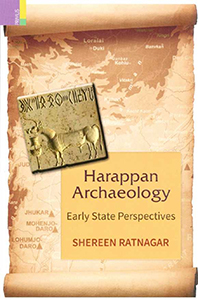
INFORMATION
- AUTHOR : Shereen Ratnagar
- HB ISBN : 978-93-84082-60-4
- Year : 2015
- Extent : x + 350
- Discount available on checkout
- Usually dispatched within 3 to 5 working days.
Harappan Archaeology
| HB ₹ 2195 . $ . ₤ |
PB ₹ . $ . ₤ |
|
| POD ₹ . $ . ₤ |
e-Book ₹ . $ . ₤ |
INFORMATION
- AUTHOR – Shereen Ratnagar
- ISBN – 978-93-84082-60-4
- Year – 2015
- Extent: 400 + 40 coloured illustrations
- 10% discount + free shipping
- Usually dispatched within 3 to 5 working days.
This book approaches the archaeology of the Harappan culture of Pakistan and India from the view point of the early state. It attempts to tease out information on the mobilization of labour, the organization of production, the direction of overseas trade by a newly formed elite, and the management of scarce water resources by the rulers. It discusses the environment and productivity of the culture, the sequence of excavations, early ideas of the civilization as quintessentially Indian, evidence for warfare and the hand of the state behind certain kinds of settlement morphology and artefactual equipment. It asks whether the residents of Mohenjo-daro lived in kin-group clusters, and attempts to explain, through cross-cultural analogy, why the citadel sites are located where they are. A new idea on sailing routes is tentatively suggested, and it is argued that it was elite intervention and management that secured both floodwater supplies at Dholavira and some degree of urban sanitation at Mohenjo-daro. Multiple views of the reasons for the end of the civilization are discussed in the final section of the book.
The Author
Shereen Ratnagar is Tagore National Fellow and former Visiting Chair Professor at the University of Hyderabad. A trained archaeologist on India and Mesopotamia, she took early retirement from a Professorship at the Jawaharlal Nehru University to work independently in the field. Her recent publications include Understanding Harappa (2001), Trading Encounters: From the Euphrates to the Indus (2004) and Ayodhya: Archaeology after Excavation (with D. Mandal, 2007). Her interest in tribal people and ethno-archaeology is reflected in The Other Indians: Essays on Pastoralists and Prehistoric Tribal People (2004), Makers and Shapers: Early Indian Technology in the Household, Village and Urban Workshop (2007) and Being Tribal (2010).
This book approaches the archaeology of the Harappan culture of Pakistan and India from the view point of the early state. It attempts to tease out information on the mobilization of labour, the organization of production, the direction of overseas trade by a newly formed elite, and the management of scarce water resources by the rulers. It discusses the environment and productivity of the culture, the sequence of excavations, early ideas of the civilization as quintessentially Indian, evidence for warfare and the hand of the state behind certain kinds of settlement morphology and artefactual equipment. It asks whether the residents of Mohenjo-daro lived in kin-group clusters, and attempts to explain, through cross-cultural analogy, why the citadel sites are located where they are. A new idea on sailing routes is tentatively suggested, and it is argued that it was elite intervention and management that secured both floodwater supplies at Dholavira and some degree of urban sanitation at Mohenjo-daro. Multiple views of the reasons for the end of the civilization are discussed in the final section of the book.
The Author
Shereen Ratnagar is Tagore National Fellow and former Visiting Chair Professor at the University of Hyderabad. A trained archaeologist on India and Mesopotamia, she took early retirement from a Professorship at the Jawaharlal Nehru University to work independently in the field. Her recent publications include Understanding Harappa (2001), Trading Encounters: From the Euphrates to the Indus (2004) and Ayodhya: Archaeology after Excavation (with D. Mandal, 2007). Her interest in tribal people and ethno-archaeology is reflected in The Other Indians: Essays on Pastoralists and Prehistoric Tribal People (2004), Makers and Shapers: Early Indian Technology in the Household, Village and Urban Workshop (2007) and Being Tribal (2010).
Table of Contents
Table of Contents
| List Of Maps, Figures And Illustrations | vii-viii |
| Preface | ix-x |
| Introduction | 1-7 |
| Part I | |
|---|---|
| The Harappan Civilization And Its ‘World’ | 11-32 |
| Part II: Historiography | |
| Discoveries, Regional Variations, And The Interpretations Of Harappan Origins | 35-54 |
| A Past To Mirror Ourselves | 55-79 |
| Interpretations Of Settlement Morphology | 80-95 |
| Part III: Members Of State | |
| Standardization | 99-107 |
| Townsman And Tribesman At Mohenjo-Daro | 108-13 |
| Archaeological Indicators Of Political Unification: A Cross-Cultural Approach | 133-158 |
| Part Iv: Waterscapes | |
| The Ocean: State-Administered Overseas Trade | 161-175 |
| Flash Flood Harvesting And Waste Water Management | 176-199 |
| Part V: Dissolution | |
| Approaches To The End Of The Civilization And The Concept Of A Traditional Society | 203-235 |
| Climate Change And The End Of The Great Tradition | 236-252 |
| In Retrospect | 253-256 |
| References | 257-285 |
| Index | 319-326 |




